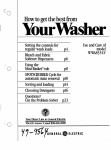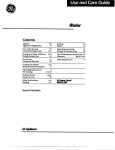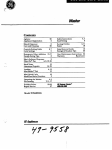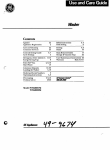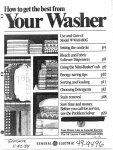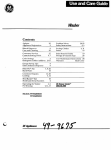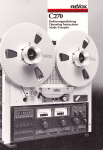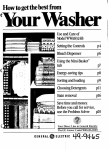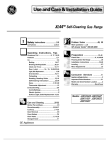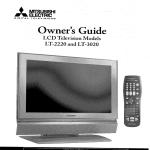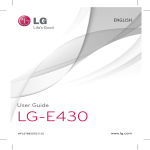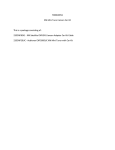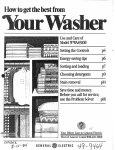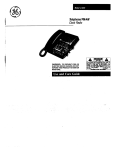Download GE WWA8324G User's Manual
Transcript
Howtogetthe best from
Settingthe controls
Bleachdispenser
Usingthe
Mini-BasketTM
tub
Energy-saving
tips
Sortingandloading
Choosingdetergents
Stainremoval
Questions?
Usethe ProblemSolver
p4
p8
Useand Careof
model
WWA8324G
p9
plo
pll
p13
p18
.
p20
Your Direct Line to General Electric
The GE Answer Centd? 800.626.2000
w
GENERAL@
—
ELECTRIC
4q-q 5s0
COntents. -
.
Help us
help you...
.A
Safktyinstructions . . . . . . . ...3.4
How to operate your
washer .*.. *. . . . . . . . ..-.. *.4.5
Controls setting guide for
different fabrics and loads . ...6.7
Before using your washer,
read this book carefully.
Write down the model
and serial numbers.
It is intended to help you operate
and maintain your new washer
properly.
You’llfind them on a label on the
lower left side near the front.
These numbers are also on the
Consumer Product Ownership
Registration Card that came with
your washer. Before sending in this
card, please write these numbers
here:
Keep it handy for answers to your
questions.
How to use the Bleach Dispenser. 8
How to use the soak setting . . ...8
If you don’t understand something
or need more help, write (include
your phone number):
Consumer Affairs
General Electric Company
Appliance Park
Louisville, KY40225
How to use the
Mihi-Basketw tub . . . . . . . . . . ...9
Energy-saving tips . . . . . . . . ...10
Howtosortthe
clothes . . . . . . ..ll
It pays to check and
pre-treat . . . . . . . . . . . . . . . . . ..ll
Model Number
Serial Number
Use these numbers in any
correspondence or service calls
concerning your washer.
If you received a
damaged washer...
Soaking . . . . . ..+ . . . . . . . . . . ..ll
How to load your washer . . . ...12
Immediately contact the dealer
(or builder) that sold you the
washer.
What is the best size load
of clothes? . . . . . . . . . . . . . . . . . . 12
Factors to consider in
selection of detergents
and soap . . . . . . . . . . . . . . . . . ..13
Toobtain Hispanic version of
this book, call
The GE Answer Center@
800.626.2000
consumer information service.
Toll-free.
Save time and money.
Before you request service ...
check the Problem Solver on
pages 20-25. It lists causes of minor
operating problems that you can
correct yourself.
The results of continued use
of carbonate detergents. . . . . ...14
How much detergent or soap
should youuse? . . . . . . . . . . . . . . 15
Para obtener la version en
espafiol de &te manual,
name gratis a
The GE Answer Center?
servicio de inforrnacion
para el consumidor,
telefono 800.626.2000.
How to use detergent
or soap . . . . . . . . . . . . . . . . . . ..15
Hard water-do you
haveit? . . . . . . . . . . . . . . . . . ...16
All washing instruction terms in this book conform to the Care Labelin~
Rule established by the Federal Trade Commission, January 1984.
“
Other laundry products. . . . . ...17
Howto remove stains . . . ...18. 19
The Problem Solver . . . . ...20-25
User maintenance
instructions . . . . . . . . . . . . . . ..26
Ifyouneed service . . . . . . . . . ..2’7
Warranty . . . . . . . . . .. Back Cover
‘
FOR YOUR SAFETY
I
FOR YOUR SAFETY
If you smell gas:
1.- Open windows.
2. Don’t touch electrical
switches.
3. Extinguish any open
flame.
4. Immediately call your
gas supplier.
I
I Do not store or use
gasoline or other
flammable vapors and
liquids in the vicinity of
this or any other
appliance.
I
IMPOIIIANT SAFETY INSTRUCTIONS
Read all instructions before using this appliance.
W-G–TO
reduce the risk of
fire, electric shock, or injury to
persons when using your appliance,
follow basic precautions, including
the following:
● Use this appliance only for its
intended purpose as described in
this Use and Care Book.
● This washer must be properly
installed and located in accordance
with the Installation Instructions
before it is used. If you did not
receive an Installation Instructions
sheet with your washer, you can
obtain one by contacting the service
location nearest you.
–Properly ground to conform with
all gowning codes and ordinances.
Follow details in Installation
Instructions.
o
-.
–Install or store where it will not
be exposed to temperatures below
freezing or exposed to the weather.
–Comect to a properly rated,
protected and sized power supply
circuit to avoid electrical overload.
–Connectto adequate plumbing
and drain facilities as described in
the Installation Instructions.
● T~
off~ter fiuce@ when
the washer is not in use to relieve
pressure on hoses and valves, and to
Of V&2
kakageifahose
+inimim
,,
shm.ddbreakor rupture.’
‘“*~~~ (&()~~
tipphncepullby theplug rather
thanthecord to avoid damazeto the
~ cordorjunction of cord an~phg.
Makesurethatthe coidiskxated so
thatit will nothe stmned m. &irmed
To minimiz e the possibility
—
of injury:
Close supervision is necessary
if this appliance is used by or near
children. Do not allow children to
● DO not mix chlorine
bleach
with
play inside, on or with this appliance
ammonia or acids such as vinegar
or any discarded appliance. Dispose
and/or rust remover. Mixing can
ofdiscaded appliancesandshippingor
produce a toxic gas which may
packing materials properly. Before
cause death.
discarding a washer, or removing
. Do not wash or dry articles
from service, remove the washer lid.
that havebeen cleaned in, washed
. Keep all laundry Ads (such m
in, soaked in, or spotted with
detergents,bleaches, fabric softeners,
combustible or explosivesubstances
etc.) out of the reach of children,
(such as gasoline, degreasers,
preferaliyinalockedcabinet. Observe
dry-cleaning solvents, kerosene,
all warnings on container labels to
etc.) which may give off vapors that
avoid personal injury.
could ignite or explode.
. Keep the area around and
Do not add these substances to the
underneath your appliances free
wash water, and do not use these
fiomtheaccumulation ofcombustible
substances around your washer
materials, such as lint, paper, rags,
and/or dryer during operation.
chemicals, etc.
. HYDROGEN GAS is produced
. Keep the floor around your
by the chemical action within your
appliances clean and dry to rwluce
water heater and the gas can
the possibility of slipping.
accumulate in the w-~r heater
● To minimhe the possibility
and/or water pipes if hot water has
of
electric shock, unplug this
notbeen used for a period of two
appliance
from the power supply
weeksor longer. HYDROGEN GAS
before
attempting
any maintenance
CAN BE EXPLOSIVE UNDER
or cleaning (except the removal and
THESE CIRCUMSTANCES. So to
cleaning
of the lint filter).
prevent the possibility of damage or
N(YIX:
lhming
the Cycle Selector
injury, if you have not used hot
knob
to
an
OFF
position
does NCYI’
water for two weeks or more, or
disconnect the appliance fiomthe
move into a residence in which the
hot water systernlmaypot have been ~ power supply.
I
with c&trols. u~ for bmethiiejturii b6Wlh@ -; ““ ~● ~ ~~ ~~r
water fkucets and allow them to run
● Do tiqH’a*th:”
.-=l:nmfia”
.for several minutesbt$fomusing any ~“ ifit is damaged, malfunctioning, . . ,1
ekctricd appliance which is :~
partially disassembkxi. orki.s
‘;
connectedtothe hot water&stem.
j
missing 01 uAursu~
This Willalkw a@ly@ogeng=@ ~
edcordor~
escape. Since the gas iiifbrnmable,
“ q
. N~er c~b on or s~d on tie
1
do not smoke oruse an ommfJ=●
El
~POrtant
Stiety
Instructions
Do not wash fiberglass ,@cles
washer. Skin irritation
.“ <could result from the reb
~
particles that may be picked up
‘ by clotig
during subsequent
washer use.
.
(continued)
● The laundry process can
reduce the flame retardancy of
iiibrics. To avoid such a result, ,
the garment rnanui%cturer’s care
instructions should be followed
very carefully.
●
inyour
For washer operation
● Do not leave washer lid up
during cycle. This will stop the wash and spin action and prevent
completion of the cycle.
SAW THESE INSTRUCTIONS
How to operate your clothes washer
W~G—TO
reduce the risk of fire, electric shock, or injury to persons,
read the IMPORTANT SAFETY INSTRUCllONS before operating this appliance.
1 (,
II
I
III
\
Automat!c
Two Speed
Washer
w!th M,ni .W*~h
II II
Sorting and Loading
Sort clothes carefidly by fabric
type, weight, color and amount of
soil according to instructions on
page 11.
●
. Remove Filter-Flo@pan and
Mini-BasketTM.The underside of
the lid is a good place to put the pan
while loading or unloading clothes.
FULKIKM
r
...—
.“.”
““~L-
... Cao
..’ DID ~
CWD
m
cmn
● Position Filter-Flo pan on
agitator and add measured amount
of detergent. See pages 13through
17for information on detergents
and other laundry additives.
N~E: Do not use the Filter-Flo
pan as a wash basket. Do not put
any items to be washed in the
Filter-Flo pan.
. See page 8 for information on
how to use Bleach Dispenser. For
information on how to use bleaches
and fabric softeners, see page 17.
● Close lid, washer will fill but not
agitate or spin with lid open.
II II
[(
IIJSTAJIT. fu?nlUS’KP
1111
)
Setting the Controls
Use the Controls Setting Guide on
pages 6 and 7 to help you make the
proper selections.
~ Select Water Level
SMALL: Washer is less than 1/2
full of clothes.
MEDIUM: Between 1/2 and 2/3
full.
LARGE: Over 2/3’s full.
MINI-BASKET: See instructions
on page 9.
Q Select Wash and Rinse
Temperature.
@ Push Cycle Selector Knob in
and turn clockwise to your selected
wash setting.
Do not use Mini-Basket tub when
washing regular loads. You’llfind
complete details on how and when
to use the Mini-Basket tub on
page 9.
Regular Cycle—
automatically provides Normal
Wash Speed and Normal Spin
%eed.
c Load clothes into the wash basket
being careful not to overload.
Clothes should be below the
retaining ring. See page 12for
more loading information.
A
4
e
Tips to Help YouSelect Settings
Perm Press& Knits Cycle—
Automatically provides Gentle
Wash Speed and Gentle Spin
Speed.
Regular Cycle—
Soak Setting–
For most cottons, linens, work and
play clothes. Three soil level
settings are provided, but you can
set the selector in-between, if
desired. Selection of these settings
automatically provides for Normal
Wash Speed, Fast Spin.
Use with most soaking aids to
loosen embedded soils and stains.
See page 8.
Regular
Cycle
mM
SPEEO
F19fJu19r
cYo10
—
s?EEO
@ Pull Cycle Selector Knob out
to start the washer. If you wish to
change setting after washer has
started, push Cycle Selector Knob
in to stop the washer and reset to
the new position. Setting can be
changed at any time.
Perm. Press&Knits
Cycle–
For Polyester Knits, delicates and
permanent press. An extended
cooldown spray rinse is provided to
minimize the setting of wrinkles.
Selection of these settings
automatically provides for Gentle
Speed Wash, Slow Spin.
/ ~scm
Ll&l
/
Perm.
Press
E Knits
Cycle
GENTLE
swim
d!!)
I
/
‘OFF
\
What Happens in Each Setting (Approximate Minutes)
Regular Cycle
Normal Speed Wiwh,Fast Spin
Cycle
Heavy
Selector
settings
18
Wash
3%
spin
31/$
Rinse
7
Spin
Total‘15me 34
Normal
14
3$5
3%
Light
Soil
Soak
Perrn.& Knits Cycle
Gentle Speed Wbh, Slow Spin
~
Normal
soil
Light
3%
7
7
7
30
22
11
Rinse Starts Here
Spin Starts Here
3%
z%
lo%
6
3%
31/$
~
2%
3%
3?4
41~
23~
41/+
16!4
NCYCES:
Totaltimeincludespausesbetweeneachphaseofcycle.
Totaltimedoesnotincludewaterffl time.Filltimesvarydependingonhousehold
waterpressureand your selected water level.
●
●
5
I
TURN THE PAGE
for Controls Setting Guide
>
Controls Setting Guide for different fabrics and loads
Load
Wash Water
Temperature
Cycle
Cottons and Linens
White/Colorfast
Bright/Non-colorfast
Hot or Warm
Warm or Cold
Regular Cycle (Normal Speed)
Regular Cycle (Normal Speed)
Work Clothes
Heavy soil
Hot
Regular Cycle (Normal Speed)
Average soil
Permanent Press, Treated Cottons,
Blends with Cottons
Heavy or oily soil
Average or light soil
Synthetics-Polyester, Nylon,
Acrylic Knits and Woven Fabrics
Sturdy
Delicates
I
Cycle Setting
~ Normal or Light Soil Setting
Normal or Light Soil Setting
I
I
Normal for small loads;
Heavy for all other loads
Normal Setting
Hot or Warm
Regular Cycle (Normal Speed)
Hot
Perm. Press& Knits Cycle
(Gentle Speed)
Perrn. Press& Knits Cycle
(Gentle Speed)
Normal Soil Setting
Perm. Press& Knits Cycle
(Gentle Speed)
Perm. Press& Knits Cycle
(Gentle Speed)
Normal Soil Setting
Warm
Warm
Warm
m
Normal Soil or Light Setting
Light Setting
Silks, Wools; Blends of Silk
and Wool
Warm
Perm. Press& Knits Cycle
(Gentle Speed)
Light Setting
Rayon and Acetate
Warm
Perm, Press& Knits Cycle
(Gentle Speed)
Light Setting
Down-filled garments, if machine
washing is recommended
Warm
Perm. Press& Knits Cycle
(Gentle Speed)
Normal Soil Setting
Baby Clothes—Sturdy, such as
Diapers, Nightgowns, Shirts, Pads,
Sheets, Receiving Blankets,
Coveralls
Hot
Regular Cycle (Normal Speed)
Normal or Light Soil Setting
Baby Clothes—Delicate
Warm
Perm. Press& Knits Cycle
(Gentle Speed)
Light Setting
Blankets-Wool, Part-Wool,Cotton
Warm
Regular Cycle (Normal Speed)
5 min. soak then Light Soil Setting
Blankets-Synthetic, Electric
Warm
Regular Cycle (Normal Speed)
5 min. soak then Light Soil Setting
Curtains-DO NCYI’
MACHINE
WASH FIBERGLASS
Hot or Warm
Perm. Press& Knits Cycle
(Gentle Speed)
Normal Soil Setting
Chenille Bedspreads, Robes*
Hot or Warm
Perrn. Press& Knits Cycle
(Gentle Speed)
Normal Soil Setting
Slipcovers, Draperies, Bathmats
and RuM**
Hot or Warm
Regular Cycle (Normal Speed)
Normal or Heavy Setting,
depending on amount of soil
Denims (especially Indigo Blue
Jeans) and other fabrics that bleed
Cold or Warm
Regular Cycle (Normal Speed)
Normal or Light Soil Setting
Rubber-coated Items, Laminated
Fabrics, Vinyl, Plastics and
Articles with Plastic Trim
Warm
Perm. Press& Knits Cycle
(Gentle Speed)
Normal Soil or Light Setting
Pillows
Warm
o
Normal Soil or Light Setting
e
**Check size some slipovem 9drawrie~ and ~sPread~
may ~ tw large for automatic home-size washer.
6
.
Refer to Garment Manufacturers’ Care Labels
9
.
Bleach
Special Instructions
Liquid chlorine type.
Only non-chlorine bleach when needed.
If colorfast is unusually soiled, use hot water. Use maximum detergent recommended on
page 15.
White or colorfast, liquid chlorine type.
Non-colorfast, only non-chlorine bleach
when needed.
Use maximum detergent recommended in chart on page 15.
White or colorfast, liquid chlorine type.
Non-colorfast, only non-chlorine bleach
when needed.
Small loads reduce wrinkling. Use maximum detergent recommended in chart on page 15.
White or colorfast, liquid chlorine type.
Non-colorfast, only non-chlorine bleach
when needed.
If unusually soiled, use hot water. Use maximum detergent recommended in chart on
page 15.Small loads reduce wrinkling.
No bleach
Wash only if recommended by the garment manufacturer. Follow instructions carefully.
Seldom needed. If needed, use only
non-chlorine bleach.
Wash in your washer only if recommended by the garment manufacturer.
No bleach
Wash frequently to fluff up the down and retain the garment’s warmth. Wash separately. Wet
down gives off an odor which maybe absorbed by other garments. Odor disappears when
garment is dry. Treat heavily soiled areas with liquid detergent or paste made of water and
granular detergent. Close zippers. Wash 2 or 3 at a time or add towels to balance.
GARMENT MUST BE TUMBLE DRIED.
White or colorfast, liquid chlorine type.
You may prefer to use a mild type detergent. Do baby clothes separately. Pretreat spots.
Rinse diapers, nightgowns, pads and sheets after use. Keep diapers in a covered pail of cold
water and conditioning agent like Borateem brand.
Only non-chlorine bleach when needed.
You may prefer to use a mild type detergent. Do hand-knit garments by hand.
No bleach
Fill washer, add detergent, allow to dissolve before adding blanket. Do one blanket at a time.
Pretreat heavily soiled spots with liquid detergent.
No bleach
On electric blanket, sew a strong piece of cloth over plug to protect blanket and washer from
damage. Do one blanket at a time. Pretreat heavily soiled spots with liquid detergent.
White or colorfast, liquid chlorine type.
Vacuum out loose dirt before washing.
White or colorfast, liquid chlorine type.
If unusually soiled, use Regular Cycle (Normal Speed) Wash and Spin.
White or colorfast, liquid chlorine type.
Wash only 2 or 3 rugs or mats at one time. Shake before washing to remove excess dirt.
No bleach
For new “indigo blue” jeans, wash at least 3 times in very small loads with full water fill.
Jeans need ample room to move to avoid white lines at creases. May discolor plastic washer
parts. Subsequent washings will reduce discolorations, but will probably never eliminate it.
The stained parts will not discolor subsequent washing loads.
No bleach
Thmble on FLUFF (No Heat).
No bleach
Pillows are made of different materials-dacron, fiber, foam, polyester, natural feathers and
down. Many pillows can be machine washed, but manujizcturers’ cam LzbeLrmm be followed
carejidly. If washing is recommended, check pillows for weak seams or holes and mend to
prevent escape of feathexsor filling. Fill washer, add detergent and agitate for sewed minutes
to dissolve detergent. Add two pillows at a time to balance load, use high water level.
9
For more information on care labeling, send for “What’s New About CARE LABELS7
For sale by the Superintendent of Documents,
U.S. Government Printing Office, Washington, D.C. 20402.
7
How to use the
Bleach Dispenser
How to Use the
Soak setting
● Use this dismnser with liauid
bleach only. ~ you prefer to;se
powdered bleach, pour it into the
Filter-Flo pan or wash basket along
with your detergent. Do not put
powdered bleach into the bleach
dispenser.
● “SOAK” setting temperature
will automatically be cold.
● Measure bleach carefully. Here
are some recommended amounts:
LARGE WATERLEVEL—1% CUP
(310ml) liquid
SMALL WATERLEVEL–2/3 CUP
(170ml) liquid
MINI-BASKET tub-1/4 CUP
(60 ml) liquid
● Pour measured amount of liquid
bleach directly into bleach dispenser.
● Do not overfill or allow dispenser
to overflow. Avoid splashing.
Undiluted bleach can cause fabric
damage.
● Never pour undiluted liquid
bleach directly onto clothes or
into the wash basket or MiNBasket tub.
s If a hot or warm soak is desired,
set the WASH/RINSE
TEMPERATURE switch to
“H~/COLD” or “W~/COL~’
and turn the Cycle SelectorKnob to
“Normal” inthe RegularCycle. Start
the washer.After washer fills and
begins to agitate,push in the Cycle
SelectorKnob and turn to “SOAK’
Pull out the Cycle SelectorKnob to
completethe cycle.
● For an extendedsoak alluwthe
washerto fill and agitatefor a few
minutes to dissolvethe soaking
agent. Then push in the Cycle
SelectorKnob to stop the washer
(&p lid closed) and wow to soak
for as long as desired. After desired
soak period, pull out the Cycle
Selector Knob to complete the cycle.
How to use the Mfi-Baskr
@
tub
7. Close lid and set controls as
follows:
The Mini-BasketTM
tub, designed
for small loads of regular fabrics
or delicate hand-washables, can
be used with any cycle except the
SOAK setting.
Water
mm
Typical Mini-Basketm tub
wash loads
Small loads of regular fabrics
(up to 2% pounds).
. Delicate loads such as lingerie,
panty hose, girdles,blouses, sweaters,
socks, shirts, baby clothes and other
small, delicate hand-washables.
. Stuffed toys.
● Tennis shoes.
●
How to wash a small
load of regular fabrics or
delicate hand-washables
1. Remove Filter-Flo pan.
:% SMML
@
4. After loading clothes in the
Mini-Basket tub, be sure to replace
the Filter-Flo pan. The pan serves
as a lid to keep the clothes in the
Mini-Basket tub.
5. put 1/4to 1/3 CUp(60 to 80 ml)
detergent into Filter-Flo pan.
& Add bleach, if desired. Measure
carefully and pour recommended
amount of liquid bleach—1/4cup
(60 ml)-directly into the bleach
dispenser. See page 8 for dispenser
instructions.
2. Place Mini-Baskettub on agitator.
Pull the agitator toward the front of
the machine for easier installation
and removal of Mini-Basket tub.
3. Load clothes in Mini-Basket tub.
See page 11for sorting help.
I
Special instructions for use of the Mini-Basketm tub
. DOnot use the Mini-Basket tub
with SOAK Setting.
. DOnot wash clothes in the regular
wash basket when using the MiniBasket tub. There will not be
enough water in the regular basket
and clothes damage could result.
a
when washing StOCkingS,p~ty
hose and other easily tangled
items, always handle separately. To
minimize tangling, the use of a net
laundry bag is recommended.
●
Level
LARGE
MINI...
BASKET ““”
–Set Water Level to “MINIBASKET” position.
—Select desired Wash/Rinse
Temperature. See .—
page 4.
8. Pull Cycle Selector knob out to
start washer.
Energy-SavingTips
If your clothes and household items
don’t look clean and fresh after
washing, you will probably re-wash
them .. .and that means you’ll waste
energy. Remember to sort your
clothes carefully, and load them
properly, select correct cycles, use
enough detergent and choose a
.
water temperature warm enough to
release and get rid of soil.
● Use Hot Wash—upto 150°F.-on
a regular basis only when washing
heavily soiled articles-such as
work and play clothes.
I
● Under normal soil conditions,
wash in water above 80°F. (Z7°C.).
This generally means using the
Warm Wash temperature setting
on your washer—temperatures
approximately 90° to llO°F. or
hand comfortable. If you notice
that soil has accumulated after
several consecutive washings, use
Hot Wash occasionally, if safe
for fabrics.
● Try to wash less often. Save
articles of the same type of fabric
until you have a full load.
● If you must wash smaller loads,
adjust the amount of water. Small
loads should have lowerwater levels.
● Wash in off-peak utility hours.
Yourlocal utility can tell you which
are the off-peak hours.
● Use Normal Spin Speed to remove
more water and help lessen drying
time. The dryer will remove any
wrinkles caused by the Normal Spin.
QUse your Mini-BasketTM
tub for
very small loads. It uses less water
than the small water level in the big
tub on this washer. You will also
save on detergent and energy.
10
-
.—-.. . . ...—. -
How to sort the clothes
9
Sort by surface texture
Sort by soil
Separate
Separate
w
It pays to check and prepare
clothes for washing.
w
from
from
,
—
Medium
Soil
\i
LINT PRODUCERS— Such as
terry toweling and chenille—give
up lint.
LINT COLLECIK)RS— such as
man-made fibers and napped
fabrics like velveteen and corduroy
—attract lint. These must be
washed separately.
For more information on lint
control, see page 20.
Sort by fabric
● Separate
w
Sort by color
Separate
,
—
Whites
13
T?
from
Perm Press
Cottons &
Blends
from
from
from
9
w
In addition to sorting to reduce lint
collection, it is recommended that
fabrics of similar construction be
washed together whenever possible.
● Remove stains. For STAIN
REMOVALGUIDE, SEE PAGE 19.
Soaking and Pre-treating—
a good way to loosen deep soils
and stains.
Lights
m
Check all items for areas of heavy
soil or stain.
Turn Poly Knits inside-out to
minimize fabric surface damage.
●
,
● Do any necessary mending—rips,
hems, tears.
from
from
from
● Empty pockets, brush out cuffs,
zip zippers, snap snaps, hooks
and buttons.
w
FOR INSTRUCTIONS ON
DIFFERENT FWKICS AND
LOADS, SEE PAGES6 and 7.
11
A thorough soaking with detergent
or special soaking agent is another
way to remove heavy soils,
embedded dirt and even some
stains.
Soaking can be either a completely
separate washing step or a preliminary step to a complete wash cycle.
For detailed information on how
to soak in your washer, see page 8.
FOR INFORMATION ON
SOAKING AGENTS, SEE
PAGE 17.
● Pre-treat heavy soil by rubbing in
a small amount of liquid detergent
or a pastemade ofwaterandpmwlered
detergent or soap. For best results,
wait 1/2 hour before washing.
How to load your washer
Special recommendations
for washing permanent press
if you do not have a dryer.
If you are machine-washing
Permanent Press clothes that you
plan to line dry or drip-dry, use
extra care to minimize wrinkling
in the wash process:
● Be careful not to overload
washer. Permanent Press clothes
must have ample room to move
freely. A Medium size Permanent
Press load is the largest that should
be washed.
● Use more water than you would
for a regular load. Use a Medium
Water Level for a Small Load; a
Large Water Level for a Medium
Load.
● Remove clothes promptly as
soon as washer stops and hang
immediately.
● To minimize wrinkling, use the
Perm. Press& Knits (Gentle Speed
Cycle).
●
Load clothes dry.
● Take a properly sorted group of
clothes and drop them loosely in
the wash basket in this order:
Large Items-1ike sheets. Do not
wrap around the agitator.
Small Items—like washcloths.
Q
Medium Size Items-like
Here is a typical full load:
3 Double Sheets
4 Long Sleeve Shirts
3 Boxer Shorts
6 Standard Pillow Cases
5 T-shirts
2 Pair Trousers
3 Handkerchiefs
towels.
This illustration, with clothes just
reaching the Clothes Retaining
Ring, shows a proper load. Clothes
have ample room to move because
they are not packed down, nor
wrapped around the agitator.
Clothes are loaded dry since wet
items are apt to pack down which
encourages overloading. This size
load requires a full water fill.
To add items after the washer has
started.
● Tum off the washer.
● Carefully remove the Filter-Flo
pan.
● Add any additional articles by
submerging next to the agitator.
● Replace the Filter-Flo pan and
restart the washer.
What is the best size load of
clothes—large, medium, or
small? Save time, energy and
detergent by avoiding extra use of
the washer. Try to wash a full load
of clothes, If you can it is better to
save clothes until you have a full
load. If you must wash smaller
loads, save water, energy and
detergent by adjusting the water
level for the size of the load. See
page 4.
N(YT’E:Do not use the Filter-Flo
pan as a wash basket. Do not put
any items to be washed in the
Filter-Flo pan.
12
N~E: When washing stockings,
panty hose and other easily tangled
items, always handle separately. To
minimize tangling, we recommend
the use of a net laundry bag.
@“r
Factorsto consider in selecting detergentsand soap
Products
Advantages
Disadvantages
Phosphate—
Powdered Detergents
Pefiorm well in hard or soft water
Are not available in some areas.
Wash all types of fabrics well.
Can be used in hot, warm, or
cold water.
Non-Phosphate—
Powdered Detergents
Perform satisfactorily in soft
or moderately hard water.
Generally do not clean well in
hard water.
In some areas only non-phosphate
products are available.
May be difficult to dissolve,
especially in cold water.
Should not be used in cold water.
Those containing sodium
carbonate as an ingredient may
cause harmfid limestone deposits
on clothes and washer when
combined with hard water.
(See page 14.)
e
Liquid Detergents
Perform well in soft water.
Offer better performance in
hard water than powdered
non-phosphate types.
May not perform as well as
powdered phosphate products
when diluted in wash water.
Cleans synthetics and fabric
blends well.
Are excellent as concentrates
for removing spots.
Completely dissolve even in
cold water.
Soaps
Perform well in soft water.
Generally do not clean well in
medium-hard or hard water.
May combine with water
hardness minerals to form
sticky soap curd.
13
The results of continued use of carbonate detergents
Is your water hard? If it is, and
if you use a carbonate type nonphosphate detergent, you will
most probably notice limestone*
deposits on your clothes and
washer surfaces. The hardness
of your water and your washing
frequency will determine how
rapidly the limestone will build
up. If ~our water is VERY HARD
(11or more grains) and if you wash
just a few loads a week, you may
see limestone buildups in just a few
months.
EffQcts on clothes
Recommended methods to
reduce limestone buildups
● hxase
Use of bleaches, p~ti,
packagedwater conditioners, prewash
soil and stain removers to help in
removing stubborn soils and stains.
Although limestone buildup occurs
more rapidly on cotton, it will
eventually affbct various fhbrics in
the following ways:
● Gives a stiff, harsh, rough feel to
fabrics such as toweling.
● Causes colors to fade and become
dull and dingy.
●
Causes graying of fabrics.
Leaves a white, powdery residue
on dark-colored items.
● Use a powdered phosphate
detergent or a liquid detergent if
these are available in your area.
. Install a home water sofl.ener.
This will significantly reduce
limestone buildup.
● Use a packaged non-precipitating
water softener, such as Calgon
brand with phosphate.
●
Causes spot-fading of bright
colors as a result of direct contact
with detergent.
●
Reduces wrinkle-resistance of
permanent press fabrics.
●
● Destroys effectiveness of flameretardant finishes on cottons such
as children’s sleepwear.
● Increases fabric wear because
of the scrubbing action between
limestone deposits on the fabrics
during washer agitation.
13ff&4son washer
Good washing practkes
may delay limestone damag e
to clothes
The following recommendations
will temporarily delay the effects
of limestone on your clothes.
These are generally good washing
practices and will give better soil
removal whether or not you have
hard water or use carbonate
detergent.
● Use hotter wash water, for
example up to 150°F.for cottons.
This also improves oily-soil
removal.
If you wash in cooler water to
save energy, use more detergent to
promote better washing. Also be
sure to use bleach on bleachable
fabrics. Use hot water whenever
possible.
●
● Unsightly buildup on all washer
surfaces exposed to the wash
solution.
● Mat-like, crusty formations caused
by lint adhering to the sticky
limestone deposits.
●
● Add detergent and allow washer
to fill and agitate for three or four
minutes to dissolve detergent
before adding clothes.
●
● Increase amount of detergent.
See guide on opposite page for
recommended detergent amounts
in relation to water hardness.
Increased service calls because
of limestone deposits in the pump,
recirculation water hoses, filters
and other washer parts.
Reduced usefi.dlife of washer.
● Use greater care in sorting loads.
Wash very dirty loads separately
and increase detergent to help keep
dirt from redepositing on less
soiled items. Wash delicate items
separately to prevent damage from
heavy, sturdy clothes.
● Wash smaller loads to increase
cleaning action of washer.
. Use fabric softener to counteract
stiffness or harshness in clothes.
How to partially restore clothes
Once clothes have developed
deposits, they may be partially
restored by soaking in a solution
of two cups of vinegar in one gallon
of hot tap water for 15minutes.
USE A PLASTIC CONTAINER.
Then wash clothes in the washer
using detergent.
CA’’ONS:
● Do not use vinegar soak
solution in washer. The acidic
action of the vinegar may
damage the porcelain.
● Vinegar soak solution may
reduce the wrinkle-resistance
of permanent press fabrics.
● Vinegar soak may damage
the dyes in some fabrics.
*LlME!30NE-technically
called CALCIUM CARBONATE—iscausedbythe
reatilon of the calcium in the hard water with the sodium carbonate in the detergent.
14
@
- -
@
“}
How much detergentshould you use?
If the recommended amount of
detergent produces too many suds,
switch to a low sudsing detergent
brand, and follow instructions on
package.
The use of a sufficient amount
of detergent is one of the most
important things you can do to
make sure your wash comes out
clean.
How to use detergent-granular
or powdered:
Place detergent in the filter pan for
normal conditions, but, for best
results, put it next to the agitator
after the clothes have been loaded.
If your detergent doesn’t dissolve
well, predissolve the detergent in
hot water, then pour directly into
the wash basket.
Amount required varies
according to:
1. Water hardness
2. Amount of soil
3. Size of load
4. Type of detergent
5. Wash temperature
Use more detergent if
you have...
1. Hard water
2. Large loads
3. Greasy or oily soils
4. Lower wash temperature
5. Low phosphate detergent.
Using too little detergent is
a common cause of laundry
problems. Always measure
detergent in a standard
measuring cup.
Recommended amount of detergent for average soil load
1. Use recommended amount of
detergent for your load and water
hardness as shown in guide.
Water Level Setting
High Sudsing
I%wder~pe
Low sudaing
Concentrated
Pbwder Type
I
LIQUID
Large
Medium
Small
Mini
Basket
1% cups
1%cups
1%cups
‘%cup
1%cups
1Mcups
% cup
?4cup
SOFT
O-4Gr.
1 cup
% cup
‘/2cup
%CUP
o-1o
?4cup
% cup
% cup
‘Acup
Water
Hardness
VERY
HARD
10-20 Gr.
HARD
4-10 Gr.
t
Grains
I
o-1o
Grains
I
FOLLOW PACKAGE
DIRINXIONS
15
2. Other detergent types-Low
and normal suds, powders, liquids,
non-phosphate powders, follow
recommendations on package.
3. For hard water treatment, see
page 16.
I
Hard water-do you have it?
.’
Before you can decide what to do
about hard water, you need to know
if you have it and, if so, how hard
it is.
. If you live in a municipal area,
contact your water company.
. If youliveinarural~,
or in
some suburban areas, contact your
county agent.
The answer will be “you have ‘so
many grains’ per gallon” and
means this:
Oto 3 grains per gallon-SOFT
4 to 10grains-HARD
11to 19grains-VERY HARD
20 grains and over—
EXTREMELY HARD
If your water is SC)FT,you have f
no problem. Youcan use soap or
detergent as you prefer and forget
all about hard water. If you have
HARD vmter-less than 10grains–
and you use phosphate detergent,
you also have no problem.
But, if you have more than 10
gtis, yOuwill need to soften your
water with either. . .
1. An installed water softener in
your home, or
2. The use of a packaged water
softener.
For information on water
softeners, see guide below.
Add this much water softener with a full water level
Grains of
hardness
Whenusing
with detergent
When using
with soap
o–lo.
lo–15
15-20
20–25
25–30
over 30
o
?4cup
(60 ml)
%cup
(120ml)
2Acup
(160ml)
1 cup
(240 ml)
1 cup plus 1 tablespoon for every 5 grains above
30 (240 ml plus 15ml for each extra 5 grains)
% cup
(80 ml)
35 cup
(160ml)
% cup
(180ml)
1 cup
(240 ml)
1% cups
(360 ml)
1?4cups plus 1 tablespoon for every 5 grains above
30 (300 ml plus 15ml for each extra 5 grains)
16
.—
Otherlaundryproducts
Laundry
productandtype
How to use it
Special instructions
BLEACH
Chlorine Liquid
suchasClorox brand
Use your Bleach Dispenser according to
instructions onpage 8.
l) Do notpourundiluted liquid chlorinebleach directly into
washerorondry clothes.
2) Some of today’s washable fabrics should not be chlorine
bleached suchas: NXl%cotton flame-retardant children’s
sleepwear, silk, wool, mohair, spandex, leather, or non-fast
colors. Dilute bleach before using on any fabric.
3) Check Manufacturers’ Care Labels for special
instructions.
Non-chlorine such as
Clorox 2 brand
Follow package directions.
Put bleach into washer with detergent.
1) Maybe used on all kinds of fabrics.
2) Is most effective in hot water.
Mix recommended amount with one
cup (240 ml)water and add at start of
rinse cycle.
1) Helps make clothes fluf~ and soft.
2) Reduces static electricity.
3) Use carefully. Too much may cause staining on
some clothes.
4) Do not pour directly on clothes.
S) For those recommended for adding to the wash cycle,
such as Rain Barrel brand, follow manufacturer’s
instructions exactly.
F~RIC SOFTENERS
Rinse additive such as
Downy Brand
Wash Additive such as
Rain Barrel brand
SANITIZER
Chlorine Bleach,
such as Clorox brand
Follow Package directions.
Add during wash cycle.
Use in case of infection and
contagious disease.
See under Bleach above.
Guards against infection by killing most bacteria and
viruses:
WATERSOFI’ENER
Non-precipitating
such as Calgon brand
Follow package directions.
Add at start of wash cycle.
Suspends hardness minerals in solution, keeping
water clear.
Precipitating such as
Borax brand
Follow package directions.
Use with detergent or soap in wash cycle.
Combines with water hardness minerals to form precipitate
which gives cloudy or milky appearance to water.
SOAK AGENT
Such as Biz brand
Follow package directions.
PRETREATING, STAIN
AND SP(YI’REMOVERS
Such as Spray ‘n Wash
and K2R brands
TIN’lX AND DYES
Powdered such as Rit
and Tlntex brands
Follow package directions. Treat only
heavily soiled areas. Check garments’
care labels for instructions.
CAUTION: Washer control panels and finishes may be
damaged by some laundry pretreatment soil and stain
remover products if such products are sprayed on or have
direct contact with the washer. Apply these pretreatment
products away from washer. The fabric may then be washed
normally. Darnage to your washer caused by pretreatment
products is not covered by your warranty.
Follow package directions.
NOI’E: Tinted garments may not be
colorfast. Wash separately.
Clean washer to avoid discoloration of next load. Go
through complete cycle (5-minute wash) using hot water,
l/2 cup (120ml) detergent, 1 cup (240 ml) bleach. Wipe
exterior parts. Caution: Tinting may discolor plastic in
washer. Subsequent washings will reduce discoloration
but may never eliminate it.
*For more information on s~t~m,
send for Government Bulletin, #5’7B,“Sanitation in Home Laundering’ available from the
Consumer Information Center, Pueblo, Colorado 81009.
How to remove stains
‘
.--*........+
1. Try to remove stains-as soon as ““ ‘“-’”
Sk Remoa Wt—
~~ “
possible. The fkesher the stain, the.
Using Chlorine Bleach for
. See next pagefor
Stain Removal Guide.
easier it is to remove.
White and Bleachable Fabrics.
,P,,,,:11,,,Mix l/4,.cup(66 ml) chlorine~‘“~;”
““l% mom complete infomtion on
2. Before attempting to remove
<..’.
:%w,y’~<
$&&@,j.
any stain, take these stepi: .“~l.‘;’” ,J: . bl&cti with one gallon (3.8 hter)of;+ ;.;&,-stiih-m”moval,request government
80T” “. .- bulletin
Fabncs}$“Removing
054D To obti
copy
Stainsa From
‘..,. ml ~&r—@ppro~@ly
● Find the fhbric and the finish in
.
(27°C.)-in a sink or pan. Soak
“
the chart on the next page, and use
write to: Consumer Information
stained
area
for
5
minutes
and
only recommended methods.
Center, Pueblo, Colorado 81009.
launder in washer.
● Check the care label instructions
Atiable at low cost.
The Case of the “Invidble” Stain.
that came with the garment.
Food or cooking oils on your
. Test stain removal product on a
synthetic garments may cause stains
hidden inside seam or on a sample
which
are virtually invisible and
of the material.
which you may not notice as you
● Avoiduse of hot water on
put your clothes into the washer.
unknown stain. It can set some
If these stains are not completely
stains.
&moved in the wash, the oily spots
3. Follow stain removal with a
may pick up dirt horn the wash
thorough rinsing.
water. Then they will become very
visible and you may think they were
4. Wash with recommended
caused by the wash cycle itself.
amount of soap or detergent.
■
Once these spots become visible,
how can you remove them?
● Rub in undiluted liquid detergent
and let stand 30 minutes.
● Re-wash using hottest water the
fabric can stand.
How can you prevent these
“After-You-W*h”stains?
● Increase the amount of detergent
normally used.
● Increase water temperature where
fabric will permit.
● Wash synthetic garments more
often.
t
I
!
it
I
18
8
a
Stain removal guide
stain
Adhesives
(Chewing Gum, etc.)
White and Bleachable Fabrics
See ControlSettingGuide,Bleach on Page 7
Rub with ice or immerse in very cold water. Use dull tool to
carejdly scrape off as much adhesive or gum as possible. Sponge
Other Washable Fabrics
Same as white and bleachable fabrics,
with a safe dry cleaning fluid,* then launder.
Anti-perspirants,
Deodorants
Apply undiluted liquid detergent. Rinse. If stain remains, bleach
according to Stain Removal Hint on opposite page. If color has
changed, you may be able to restore it by sponging with
ammonia.** Rinse thoroughly.
Same as white and bleachable fabrics
except use non-chlorine bleach.
Blood
Soak in cold water, then launder in warm water. If stain remains,
bleach according to Stain Removal Hint on opposite page, launder.
Sponge or soak in cool water, then launder.
Chocolate, Cream,
Ice Cream and Milk
Soak in cold water. Treat stain with a safe dry cleaning fluid*;
Apply undiluted liquid detergent, launder, dry. Bleach according
to Stain Removal Hint on opposite page, launder and dry.
Soak in cold water. Sponge with a safe dry
cleaning fluid~ Apply undiluted liquid
detergent. Launder in warm water.
Coffee and Tea
Without cream: Bleach according to Stain Removal Hint on
opposite page. Launder. With cream; Follow guide directions for
cream.
Sponge with warm water. If stain remains,
apply warm glycerine, let stand 30 minutes
and rinse well, or sponge with a safe dry
cleaning fluid.* Launder.
Cosmetics: Eye Shadow,
Lipstick, Mascara, Liquid
or Pancake Makeup, Rouge,
Powder; Crayon; Grease,
Oil, Tar, Cod Liver Oil.
Treat stain with safe dry cleaning fluid? Apply undiluted liquid
detergent; launder and dry. Bleach according to Stain Removal
Hint on opposite page.
Sponge with a safe dry cleaning fluid?
Then launder in warm detergent water.
Fresh Fruit, Fruit Juices,
Wine, Vegetables, or Food
Coloring
Soak stain in cool water. If stain remains, bleach according to Stain
Removal Hint on opposite page, launder.
Sponge with warm water. Bleach remaining
stain with non-chlorine bleach.
Grass, Foliage, Flowers,
Mildew, Scorch
Apply undiluted liquid detergent. Launder. (Treat mildew spots
while they are fresh, before mold has a chance to weaken fabric.) If
either type stain remains, bleach according to Stain Removal Hint
on opposite page, launder. (Severe scorch cannot be removed.)
Ink, Ballpoint
Fresh stains: Place stain face down on an absorbent towel and
sponge with dry cleaning fluid$ or use spray cleaner. Apply
undiluted liquid detergent. Old stains; bleach according to Stain
Removal Hint on opposite page.
Same as white and bleachable fabrics
except launder using non-chlorine bleach.
Paint and Varnish
Soften with oil, lard or Vaseline, then sponge with turpentine or
banana oil. Launder in warm water.
Same as white and bleachable fhbrics.
Perspiration
Apply undiluted liquid detergent and launder in warm water. If
color has changed you may be able to restore it by treating with
ammonia or vinegar.- If any stain remains, treat with safe dry
cleaning fluid* or bleach according to Stain Removal Hint on
opposite page, launder and dry.
Launder in warm water. Rinse well. Bleach
with non-chlorine bleach.
Rust
Apply rust remover,~ using rnanufkcturer’s directions. Rinse and
launder.
Same as white and bleachable fabrics.
Sponge with warm water. Apply undiluted
Bleach remaining stain
with non-chlorine bleach, then launder.
Old mildew stains can seldom be removed.
Scorch can seldom be removed.
liquid dete~ent.
Waution:Becausecleaning fluids tend to be toxic, be sure you are in a well ventilated room when using them. No cleaning fluid should be used unless user is
hniliar with the limitations and required cautions (usually pMted on label). Use extremecautionwith flammable compounds.
Under no circumstances should fabrics containing flammable materials (waxes, cleaning fluids, etc.) be washed in washer.
~
pI@MX
a toxic
gas which
#~ n~ w Chlonw bl~h wi~ ~ofi
or acids such ~ v~egar and/or ~st mmwer. Mixing
Saveand refer to garment manufacturers’care labels.
19
may cause death.
Questions?
gl!llia
~
Use This Problem Solver
PROBLEM
POSSIBLE CAUSEAND REMEDY
LINT OR RESmUE
ON CLUI’HES
● Incorrect sorting of clothes. Separate lint-producers (such as terry towels and chenille)
Ikomlint-receivers (such as man-made fabrics, velveteen, corduroy).
● Washing too long, especially for smaller loads. For normal soil, wash one minute per
pound of dry clothes.
● Use of non-phosphate detergents which combine with hardness minerals to form a
precipitate which can be mistaken for lint. Use a phosphate or liquid detergent; use
warmer wash water or soften water with an installed mechanical softener or a packaged
water softener.
● Powdery residue from granular detergent may appear to be lint. Predissolve granular
detergent in hot water before adding to washer; make sure detergent is completely
dissolved before adding clothes; switch to liquid orcold water detergent or use warmer
wash water. See page 15.
● Overloading will cause abrasion which creates excessive lint. Wash fewer items with
correct water level.
Tm much bleach. Use correct amount of bleach according to package directions.
● Not
wash cycle. kcrease amount of
detergent. See page 15.
●
enough
detergent
toho]d
lint
insuspension
during
● Incorrect use of fabric softener. If used in wash cycle, sofieners may react with
detergent to create a white deposit. Use sofkmers in rinse cycleonly unless package
specifies adding to wash cycle. Seepage 17for fabric softener instructions.
● pilling usu~ly on ~lYester-cotton blends is caused by normal wear and may look like
lint. Thming clothes inside-out may help.
s Static electricityy caused by overdrying will cause attraction. Use fabric softener in
rinse cycle.
GREASY OR OILY
STAINS ON
LAUNDERED
GARMENTS
i--
These are sometimes called “Invisible Stains” because you may not notice them before
washing clothes. However, if oily soils are not completely removed in wash cycle, the
oily spots may pick up dirt from the wash water. The spots will then be very visible. They
are not caused by the washer. Wash synthetic garments as soon as possible after wearing.
Use more detergent than normal and hottest water fabric can stand. If spots appear, rub in
undiluted liquid detergent, let stand 30 minutes and rewash with extra detergent using
hottest water fabric can stand.
.. ....--—. — .-.
——.
PROBLEM
POSSIBLE CAUSE AND REMEDY
GRAYED
CL~HES
● Insufficient detergent. YOU may need to increase amount of detergent used if load is
larger than normal, if soils al-e oily or heavier than average, if water level is large or if
water is Hard to Extremely Hard.
● Water not hot enough for type of load. Be sure water heater is set to deliver hot water
at the washer at 140°-150*F. Do not wash when other hot water needs—such as
dishwashing or family baths—are heavy.
Poor or inferiordetergent. Change to phosphate detergent, if possible. Follow these steps:
1. Use water conditioner, (such as Calgon brand)
2. Pre-treat stains
3. Use hottest water possible
4. Use bleach where possible
5. Use pre-soak aids
6. Install water softener
● Washer overloaded. Clothes cannot move freely to loosen and remove soil, causing
gray appearance. Follow conect loading procedures for size of load.
●
● Improper soaking with insufficient detergent. Usually a 30-minute soak is sufficient.
However, when using extended soaks for heavily soiled garments you may need to use
twice the recommended amount of detergent.
● Use of soap in hard water. Switch to a phosphate detergent, or follow six steps
described above.
● washing tm longmay result
inincreasedsoildeposition. Use shorter wash times for
smaller loads.
● Detergent dissolves too slowly. Detergent must be present in the wash solution at the
start of agitation. See page 15.
●
To restore grayed clothes, follow one of these procedures:
1. Put clothes in washer. Fill with HOT water. Check Manufacturers’ Care Labels to
determine if hot water is suitable for garment.
c Add a non-precipitating type of water softener such as Calgon with phosphate—
use 2% times as much as you need for normal water softening.
● Do not use detergent or soap.
● Allow clothes to go through complete cycle.
● Repeat, if necessary.
2. If you prefer to use the Soak Setting, see page 8. Use the water softener in place of
soak agent or prewash detergent and allow clothes to soak for about 20 minutes.
3. Use the Mini-Basket tub. Seepage 9. Increase detergent.
YELLOWED
CLOTHES
. Incomplete removal of body soil due to constant use of insufficient detergent. Check
hem of T-shirt or pillow case. If they are white and center is yellow, it contains body
oil. Restore whiteness following procedures on’ ‘Grayed Clothes;’ page 21.
21
The Problem Solver (continued)
PROBLEM
POSSIBLE CAUSE AND REMEDY
YELLOWED
CL~HES
(continued)
Chlorine bleach may yellow some Iibrics with resin finishes. Use oxygen bleach (such
Clorox 2 brand). Refer to Garment Manufacturers’ Care Instructions. Restore color
using color remover (such as Rit or T’intexbrands), follow package directions.
●
as
●
Iron or manganese in water may cause overall yellowing or yellow spots.
1. Use extra detergent plus a non-precipitating water soflener dissolved in water
before adding clothes. Use non-chlorine bleach.
2. Have a special filter or chemical feeder installed in your home to remove iron and
manganese from water.
3. Run hot water for a few minutes to clean iron residue buildup in lines; drain water
heater occasionally.
4. To remove spots: spread stained portion over pan of boiig water and squeeze
lemon juice through stain. To remove overall yellow, use a commercially available
rust scale remover, following package instructions. If porcelain damage can occur,
do not use in the washer; use a plastic container.
BLUE OR GRAY
COLOR STAINS
● Improper use of fabric softener. Never pour fhbric softener directly on clothes;
always dilute before adding to rinse water. To remove stains: dampen stained area and
rub with undiluted liquid detergent. Re-wash, using chlorine bleach if safe for fabric.
SHRINKAGE,
GENERAL
● Some fabrics will shrink whether washed in a washer or by hand; others maybe
safely washed but will shrink in a dryer. Follow Garment Manufacturers’ Care
Instructions exactly. If in doubt, do not machine wash or dry.
SHRINKAGE,
KNITS
● Relaxation shrinkage can occur in knit fabrics that have been improperly stretched
and elongated by the manufacturer. When this occurs, garment maybe pressed back
into shape after each wash and dry cycle.
● Progressive or delayed shrinkage is caused when starch or sizing (in some fabrics)
is gradually removed by laundering. May be noticed in older garments that have been
washed many times without previous shrinkage. Treat as for Relaxation Shrinkage above.
● Shrinkage caused by overheating occurs in certain knit fabrics that have been heatshaped. When washing, drying or ironing temperatures exceed the tempemtures used
to shape set, shrinkage may occur. This cannot be corrected, but it can be prevented by
washing in cool or warm water; drying on LOWor Delicate heat.
PROBLEM
WRINKLING IN
PERMANENT PRESS
AND “NO-IRON”
[TEMS
POSSIBLE CAUSE AND REMEDY
●
Leaving clothes in dryer afier tumbling stops. Remove and hang clothes immediate y.
●
Too many clothes in dryer. Dry only one washer load at a time. Do not combine loads.
● Improper loads. Avoid laundering heavy Permanent Press items, such as work
clothes, with lighter Permanent Press items such as shirts or blouses. Do not wash
Permanent Press with regular laundry.
● Too many clothes in washer. Permanent Press loads should always be smaller than
regular loads. . .no more than medium loads to give clothes room to move freely.
● Incorrect wash and dry cycles. Use Permanent Press Wash cycle which provides a
cooldown rinse to minimize wrinkling. Also use Permanent Press Dry cycle.
● Incorrect water level. Use Large Water Level for Medium Load, Medium Level for
Small Load.
c Repeated washing in too hot water. Wash in cold or warm water with plenty
of detergent.
● Accumulation of lime scale due to use of carbonate detergents. If you must use a
non-phosphate detergent, avoid the use of high-carbonate-built detergent.
●
Failure to use fabric softener. Proper use will minimize wrinkling.
To remove wrinkles:
1. Retumble on “Permanent Press” setting.
2. Rerinse and dry on “Permanent Press” setting.
3. If unsuccessful, retumble on high heat for 10-12minutes and hang immediately.
4. Iron carefidly.
5. Send to dry cleaners for pressing.
6. Some wrinkles may remain which cannot be removed.
SNAGS, HOLES,
TEARS, RIPS OR
EXCESSIVE WEAR
● Pins on garments or sharp objects left in pockets. Check to make sure all such objects
are removed. Also check wash tub.
● Snaps, hooks, sharp buttons, belt buckles, zippers. Fasten hooks, zippers and
buttons. Remove sharp buttons and belt buckles. This is especially important in
washing knits which snag easily. Tim knits inside out.
● Holes with random square shapes with yellow discoloration maybe caused by
improper use of chlorine bleach. Use only correct amount of bleach, using BIeach
Dispenser. Never add undiluted bleach to washtub or allow clothes to come into
contact with undiluted bleach. Do not wipe up bleach spills with clothes.
● Chemicals such as hair bleach, dye, permanent wave solutions, battery acids and
toilet bowl cleaners may cause fabric holes. Rinse all towels and other articles that
came in contact with these chemicals before putting them in wash. Do not contaminate
clothing articles with these chemicals.
● Small, unnoticed tears may enlarge during washing process. Check garmentsbetbre ~washing and mend all rips and tears.
I (continued next page)
23
The Problem Solver (continued)
PROBLEM
POSSIBLE CAUSE AND REMEDY
SNAGS, HOLES,
s As PermanentPress garments age, they may show fraying at collars and cuffs. This is
TEARS, IUPS ~
~ ‘ ~normal due to weakening of fibers by the Permanent Press process. It is not caused by
OR EXCESSIVE ‘ ~
‘washer. Youcan slow this process by washing small Permanent Press loads with a .,
WEAR
Large Water Level. Do not wash heavy items such as towels with Permanent Press.
(continued)
Remove collar stays, when possible.
● Roughness or burrs on agitator may cause rips or tears. Check agitator and file rough
spots if necessary.
● Maybe caused by use of Regular Cycle (Normal Speed) for delicate articles. Use
Perrn. Press&Knits Cycle (Gentle Speed). Refer to Garment Manufacturers’ Care
Labels.
● Garments weakened by age, sun or atmosphere. This is inevitable and is not caused
by washer. Slow process by washing on Perrn. Press & Knits Cycle (Gentle Speed).
● TN large loads, or too little water. Load washer only with number of items that will
move freely. Select correct water level.
HEAVILYSOILED
AREAS such as
collars and cuffs
WASHER WON’T
OPERATE
●
Pretreat with liquid detergent.
●
@@@@
Make sure cord is plugged into outlet.
●
Make sure both hot and cold faucets are turned on.
●
Make sure controls are set and cycle selector knob is pulled out to ON position.
●
Make sure lid is closed. Washer will fill but will not spin or agitate with lid open.
● Check house fuses or circuit breakers. If another appliance is sharing the electrical
outlet, remove it. Washer should have separate outlet.
WATER
TEMPERATURE
IS INCORRECI’
● Make sure temperature selector controis are
properly set.
. M~e sure hot and cold fauce~ me turn~ on
and regulated correctly.
● Make sure hoses are connected to correct
faucets.. hot to hot, cold to cold.
+
o
5{
Water valve screens may be stopped Up Remove inlet hoses from
water valve. Clean the screens and reinstall hoses.
●
●
Check household water heater to make sure it is delivering water at 140°to lSO°F.
24
PROBLEM
WATERWON’T
DRAIN
WATER LEAKS
WASHER IS NOISY
POSSIBLE CAUSE AND REMEDY
●
Make sure drain hose is not kinked.
●
Top of drain outlet should be less than 8 ft. above floor.
●
Make sure hose connections are tight at faucets.
●
Make sure end of drain hose is correctly inserted in and secured to drain facility.
● Make sure washer is level and firm to the floor with rubber foot pads in place and
front jam nuts tight. See your Installation Instructions.
● A sharp distinctive sound will be heard at the end of each spin period as the motor
stops and the spin brake inside the transmission “locks in? This sound is normal.
1
WASHER PAUSES
IN CYCLE
●
● Heavily unbalanced loads can cause the washer to vibrate excessively during spin,
and may cause it to move from its original position. In extreme cases, (usually occurs
when washing a single, heavy item or a small load when water level is set higher than
necessary) the spin basket may strike the outer tub, creating a loud but harmless noise.
To correct, open the lid and redistribute the load evenly about the wash basket. Close
the lid and restart.
● Washer normally pauses between washing steps. . .such as between wash and spin or
between spin and rinse.
If you need more help... call, toll free:
The GE Answer Center@
800.62ii2000
consumer information service
25
Cati and Cleaning
usERlwimTE&cE
How to remove limestone
deposits fmm clogged
Filter Flo” pan
INSTRUCTIONS “’”’‘
The tub. The porcelain is
self+leaning. Leave lid open after
washing to allow muisture to
evaporate. Do not use harsh
or gritty cleansers.
The exterior. W@e off any spills of
washing compounds. Wipe or dust
with damp cloth. Try not to hit
surface with sharp objects.
To store washer:
Ask service technician to remove
waterfkomdrainpump and hoses
to preventfreezing.
Do not store the washer where it
will be exposed to the weather.
For long vacations:
Be sure water supply is shut off at
faucets and drain all water from
hoses if weather will be below
fkezing.
JiijJ}with grease
or
Petroleum
Jelly.
The Activator@agitator. I&move
at regularintervals-about 4 to 6
months-and removeany lint that
-mav have accumulated. No tools
are”needed, simply grasp agitator
with both hands and pull straight
up sharply. The slot6d section at
the top of the metal shaft has a light
coating of lubricant to prevent parts
sticking together. If this area
appears to be dry, apply alight coat
of grease or petroleum jelly around
the slotted section of the shaft
before replacing the agitator. Do
not overgrease. Excess grease may
get into clothes load.
When replacing the agitator,
carefully lower straight down onto
the shaft so that it fits into the slots.
Then apply downward pressure
until agitator snaps into its normal
position.
*
26
.
s Soak filter pan in a preheated
160”F.(71”C.)solution of half
vinegar and half water for 15
minutes. Then brush each side of
pan with a stiff bristle brush while
flushing with running water.
CAUTIONS:
● Do not soak in porcelain
container. Vinegar can damage
porcelain.
● Do not exceed 180“F. (82 “C.)
or filter pan may warp.
————
—-
-—
If You Need Service
Toobtain service, see your warranty
on the back page of this book.
We’reproud of our service and
want you to be pleased. If for some
reason you are not happy with the
service you receive, here are three
steps to follow for further help.
FIRST, contact the people who
serviced your appliance. Explain
why you are not pleased. In most
cases, this will solve the problem.
NEXT, if you are still not pleased,
write all the details-including
your phone number—to:
Manager, Consumer Relations
General Electric
Appliance Park
Louisville, Kentucky 40225
FINALLY, if your problem is still
not resolved, write:
Major Appliance
Consumer Action Panel
20 North Wacker Drive
Chicago, Illinois 60606
.
n
YOUR GENERAL ELECTRIC AUTOMATIC C~HES
,
WASHER
WARRANTY
Save proof of original purchase date such as your sales slip or cancelled check to establish warranty period.
4
WHAT IS COVERED
FULL ONE-YEAR WARRANTY
For one year from date of original
purchase, we will provide, free of
charge, parts and semice labor
in your home to repair or replace
any part of the washer that fails
because of a manufacturing
defect.
LIMITED ADDITIONAL
FOUR-YEAR WARRANTY
For the second through fifth year
from date of original purchase,
we will provide, free of charge,
replacement parts for any patt of
the tmnsmission that fails because
of a manufacturing defect. You pay
for the service trip to your home
and service labor charges. Or, if
you desire, we will provide a
completely reconditioned
transmission. You pay for the
shop reconditioning labor, the
service trip to your home and
service labor charges.
WHAT IS NOT COVERED
This warranty is extended to
the original purchaser and any
succeeding owner for products
purchased for ordinary home use
in the 48 mainland states, Hawaii
and Washington, D.C. In Alaska the
warranty is the same except that it is
LIMITED because you must pay to
ship the product to the service shop
or for the service technician’s travel
costs to your home.
.
All warranty service will be provided
by our Factory Service Centers or
by our authorized Customer Care@
servicers during normal working
hours.
Look in the White or Yellow Pages
of your telephone directory for
GENERAL ELECTRIC COMPANY,
GENERAL ELE~RIC
FA(XORY
SERVICE, GENERAL ELE~RICHOl_POINT FACTORY SERVICE or
GENERAL ELE(XRIC CUSTOMER
CARE@ SERVICE.
Replacement of house fuses or
resetting of circuit breakers.
“ SefViCetripstOyourhome tO
●
teach you how to use the product.
Read your Use and Care material.
If you then have any questions
about operating the product,
please contact your dealer or our
Consumer Affairs office at the
address below, or call, toll free:
. Failure of the product if it is used
for other than its intended purpose
or used commercially.
The GE Answer Center@
800.626.2000
consumer information service
. Damage to product caused
by accident, fire, floods or acts
of God.
WARRANTOR IS NOT RESPONSIBLE
FOR CONSEQUENTIAL
DAMAGES.
c Improper installation.
If you have an installation problem,
contact your dealer or installer.
You are responsible for providing
adequate electrical, plumbing and
other connecting facilities.
Some states do not allow the exclusion or limitation of incidental or consequential damages, so the above limitation or exclusion
may not apply to you. This warranty gives you specific legal rights, and you may also have other rights which vary from state to state.
To know what your legal rights are in your state, consult your local or state consumer affairs office or your state’s Attorney General.
Warrantor: General Electric Company
If further help is needed concerning this warranty, write:
Manager—Consumer
Affairs, General Electric Company, Appliance Park, Louisville, KY 40225
GE NE RALO
ELECTRIC
(
WWA8324G





























